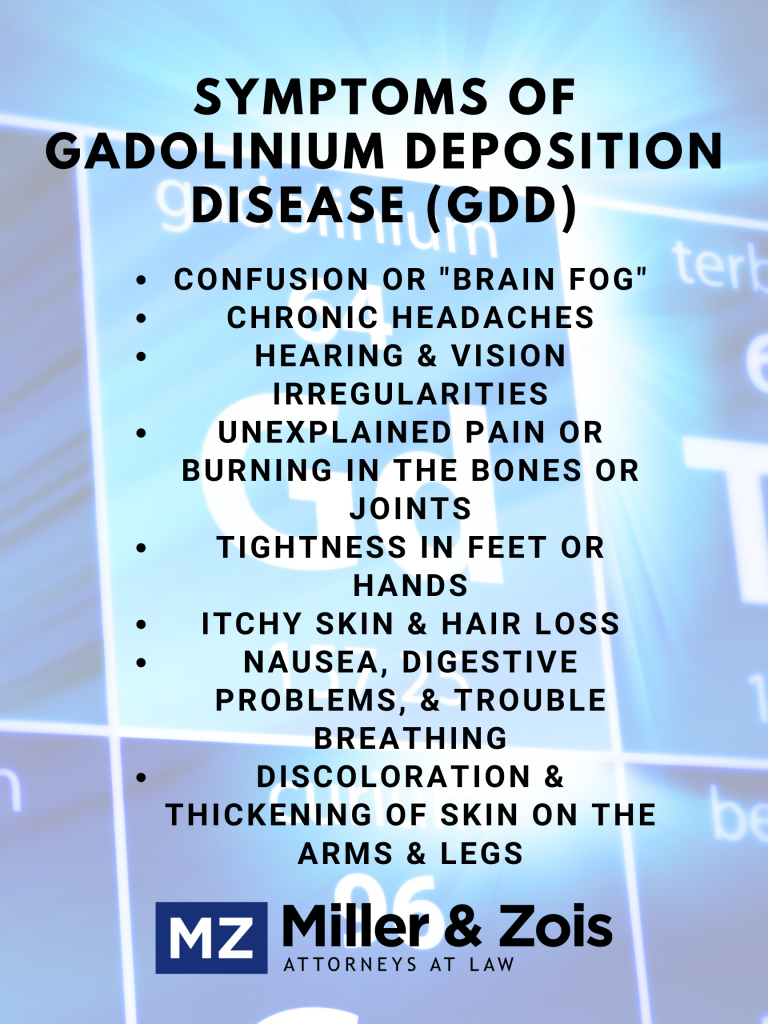Years ago, we were involved in gadolinium MRI lawsuits involving nephrogenic systemic fibrosis (NSF), which is a fibrosing disorder of the skin and joints that occurs with victims with advanced renal insufficiency.
The cases settled for millions of dollars because NSF is just an absolutely awful disease. Now there is a new set of gadolinium MRI lawsuits alleging that gadolinium is toxic and harming patients.
What is Gadolinium?
Gadolinium is a rare earth metal that has unique fluorescent and magnetic properties. It is widely used in MRI “contrast agents.” Contrast agents are ingested by patients prior to scanning in order to enhance images of internal organs on Magnetic Resonance Imaging (MRI) tests. The contrast agents make MRI imaging much more effective at diagnosing internal medical conditions by increasing the detailed visibility of organs, blood vessels, and other internal structures.
Is Gadolinium Toxic?
 The safety of gadolinium-based contrast agents (GBCAs) has recently become a major point of concern in the field of radiology. Concerns about the health risks of GBCAs first began in 2014 when a study published in the American Journal of Radiology reported, for the first time, that deposits of gadolinium were found in the brain of people who had used GBCAs. This study immediately raised many concerns because of the extensive history of clinical complaints from patients who were convinced that GBCAs had harmed their health.
The safety of gadolinium-based contrast agents (GBCAs) has recently become a major point of concern in the field of radiology. Concerns about the health risks of GBCAs first began in 2014 when a study published in the American Journal of Radiology reported, for the first time, that deposits of gadolinium were found in the brain of people who had used GBCAs. This study immediately raised many concerns because of the extensive history of clinical complaints from patients who were convinced that GBCAs had harmed their health.
 It is well known that GBCAs are not safe for people with renal insufficiency because they cannot filter the gadolinium from their system. All GBCAs contain a mandatory FDA warning label about this known risk. Prior to the study in 2014, however, there was nothing to suggest that GBCAs may be unsafe for patients with normal renal function. Publication of the 2014 study eventually prompted the FDA to issue a public safety alert in 2015 saying they were investigating the potential health risks of GBCAs. In November 2017, the safety of GBCAs got nationwide attention when actor Chuck Norris and his wife, Gina, filed a lawsuit alleging that Gina was poisoned by GBCAs she took for several MRIs. There is still no definitive evidence showing that gadolinium is toxic. Several large-scale studies are currently underway to evaluate the potential health impact of gadolinium deposits in the brain. The results no doubt dictate the future of GBCAs. However, European health officials apparently felt like there was enough evidence to take immediate action. In 2017 the European Union issued a safety recall of a certain type of GBCA known as “linear” GBCAs. Evidence has shown that linear GBCAs leave larger gadolinium deposits in the brain compared to macrocyclic GBCAs.
It is well known that GBCAs are not safe for people with renal insufficiency because they cannot filter the gadolinium from their system. All GBCAs contain a mandatory FDA warning label about this known risk. Prior to the study in 2014, however, there was nothing to suggest that GBCAs may be unsafe for patients with normal renal function. Publication of the 2014 study eventually prompted the FDA to issue a public safety alert in 2015 saying they were investigating the potential health risks of GBCAs. In November 2017, the safety of GBCAs got nationwide attention when actor Chuck Norris and his wife, Gina, filed a lawsuit alleging that Gina was poisoned by GBCAs she took for several MRIs. There is still no definitive evidence showing that gadolinium is toxic. Several large-scale studies are currently underway to evaluate the potential health impact of gadolinium deposits in the brain. The results no doubt dictate the future of GBCAs. However, European health officials apparently felt like there was enough evidence to take immediate action. In 2017 the European Union issued a safety recall of a certain type of GBCA known as “linear” GBCAs. Evidence has shown that linear GBCAs leave larger gadolinium deposits in the brain compared to macrocyclic GBCAs.
What is Gadolinium Deposition Disease?
Gadolinium deposition disease (GDD) is the name of the health condition suffered by those people who suffer from chronic health problems caused by GBCAs and the deposits of gadolinium they leave in the brain. The Chuck Norris lawsuit claims that his wife Gina suffers from “gadolinium deposition disease” allegedly caused by GBCAs she used for several MRIs.
Gadolinium deposition disease is not something that develops slowly. In many patients, the symptoms of GDD can occur within hours after the ingestion of GBCAs. The onset of GDD symptoms is often very sudden and very acute in the hours and days after the MRI procedure. The initial acute symptoms eventually progress into chronic conditions that may continue for years afterward. The noticeable symptoms of GDD include the following:
- Confusion or “brain fog”
- Chronic headaches
- Hearing and vision irregularities
- Unexplained pain or burning in bones or joints (particularly in neck & head)
- Tightness in feet or hands
- Itchy skin and hair loss
- Nausea, digestive problems and trouble breathing
- Discoloration and thickening of skin on arms and legs
With Gina Norris, the symptoms of GDD were sudden and very pronounced. After taking GBCAs for a series of MRIs, Gina Norris claims that she suddenly experienced burning pain and violent shaking, followed by numbness and tingling. These initial symptoms were followed by cognitive impairments and kidney damage.
Gadolinium Lawsuits
The lawsuit filed by Chuck Norris and his wife in San Francisco is one of a handful of similar GDD lawsuits filed by the same California law firm. The lawsuits against the manufacturers of GBCAs all allege that the gadolinium-based contrast agents essentially poisoned the plaintiffs, who now suffer from GDD. These are likely the first of many GDD lawsuits. At this point, however, the ultimate success of these GDD lawsuits may depend on the results of the ongoing gadolinium safety studies. Right now, we only have scientific evidence that the brain retains gadolinium deposits. If current testing establishes that the gadolinium deposits cause GDD, as alleged by Gina Norris and other plaintiffs, it will probably lead to a recall and thousands of new GDD lawsuits being filed across the country. (But that is not what happened.)
2019 Post-Script
These cases have not really gotten off the ground. The science is not supporting these claims in a way that plaintiffs’ lawyers had expected. Our law firm is not handling these cases.
 Maryland Injury Law Center
Maryland Injury Law Center


